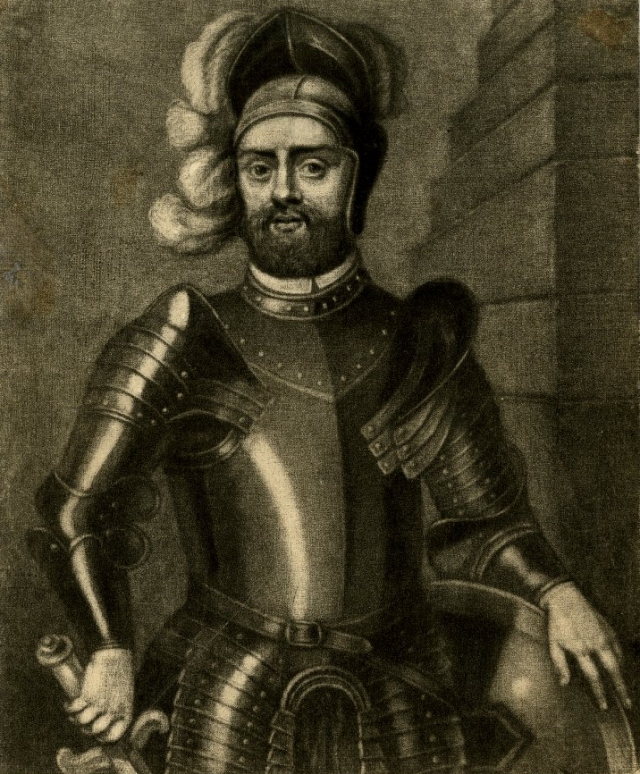
We cross the stone bridge that spans the River Tees, catching just a glimpse of the castle high up on a cliff. Parking curbside on Bridge Street, in a spot fortuitously placed at the foot of the path, we gather our cameras and British Heritage passes.
The hike is a steep one which winds around the precipice, but it feels good to walk after the long ride and good night's sleep. Halfway up, I'm appreciating my own foresight in purchasing and breaking in a good pair of walking shoes for this trip. As we near the top, the castle appears on our right. The edifice of the round tower seems to bulge out over the mound on which it sits. At the summit we are (gasping and) rewarded by a panoramic view of the river, the town and a small, but lovely, garden.
The history of Barnard Castle, which was named for Bernard de Baliol who gained ownership in 1125, is fraught with struggles between Church, Crown, England and Scotland. Earls, Bishops, Kings, Dukes – everyone who was someone coveted this castle and used whatever means available to them to claim it; whether it was political maneuvering, force, siege, marriage, or rebellion.
For over two centuries it was the principal stronghold of the Baliol family, whose main claim to fame is John de Baliol II's brief reign as King of Scotland in the late 13th century. Strategically placed upon a cliff overlooking the river and surrounding countryside, it's easy to understand why this was such a desirable property.
The extensive ruins of the castle are spread out over a large park-like area with wide expanses of greens dotted with towering trees. We've been spoiled by our luck and are a bit dismayed to find about a half dozen other visitors milling about. We do our best to take pictures around them. Wandering through the Town Ward, I imagine it filled with medieval inhabitants going about their daily tasks; it must have taken hundreds to keep this castle running.
We take our time, checking out guardhouses, walls, and a well. The adventurer in me ducks into a dark chamber, probably a storage chamber, where, through the decayed doorway I can see the castle, partially hidden by trees. I stand with my camera held to my face, waiting for quite a while for a man to move out of my shot, enjoying the cool dark atmosphere, feeling not quite alone, as if someone were there with me. Then – whoooosh! From either side of me swifts, unseen until that moment and apparently uncomfortable with my presence, take flight and burst through the opening and out into the sky.
These are the first of many swifts I will see on this trip. I'm not an avid bird-watcher, but have always found observing their behavior a pleasurable and relaxing past-time. I had already noticed the huge pigeons at Manchester airport, and that the blackbirds at Fountains Abbey looked identical to the blackbirds back home, but their call was different; they had an English accent. Dana and I had also noticed and been impressed by the size of the crows that sat perched atop the chimneys of the rowhouses across from Feversham. But I digress (again.)

In 1216 Barnard Castle was besieged by Alexander II, King of Scotland. It was still held by the Balliol family although its ownership was disputed by the Bishops of Durham. When John Balliol was deposed as King of Scotland in 1296 the castle was passed to the Bishop of Durham.
Around 1300 Edward I granted it to the Earl of Warwick. In the 15th century the castle passed by marriage to the Neville family. In 1477 during the Wars of the Roses, Richard, Duke of Gloucester (later Richard III) took possession of the castle, which became one of his favorite residences.
Read more about Barnard Castle at Wikipedia.

John Balliol (c. 1249 – 1314) was King of Scots from 1292 to 1296. In 1290 Scotland entered a period during which competitors for the Crown of Scotland put forward claims. Balliol was chosen as the new King of Scotland by a group of noblemen headed by King Edward I of England.
Edward used his influence to subjugate Scotland and undermined Balliol's reign by treating Scotland as a vassal of England. This tainted Balliol's reign; the Scottish nobility deposed him and appointed a council to rule instead.
Edward I then invaded Scotland, starting the Wars of Scottish Independence. After a Scottish defeat in 1296, Balliol abdicated and was imprisoned in the Tower of London. In time he was sent to France, and retired into obscurity.
Read more about John Balliol at Wikipedia.